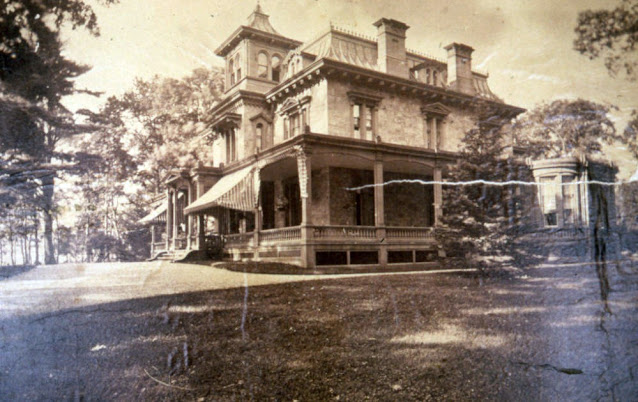The Larches: From Miss Alpine's School to stock icon's working estate
The Larches, a 46-acre estate of the financial powerhouse Whitehouse family, ran from the northeast intersection of South Broadway and Harriman Road, east along Harriman Road to just shy of today’s Irvington Reservoir.
The estate was the 1860 property of James L. Adams, became Miss Alpine’s School in 1868, and was restored as a home by James Henry Whitehouse and his wife, Mary Schenck Whitehouse, in 1888.
Little information about Adams is available, but he did represent St. Barnabas Episcopal Church as its lone delegate at an annual Anglican Diocese of New York convention.
More is known about the estate’s longest tenured occupants.
J. Henry Whitehouse was the son of Edward Whitehouse, the founder of New York Stock Exchange firm Whitehouse & Co., founded in 1828. J.H. was a member of the New York Stock Exchange for 67 years and a partner in Whitehouse & Co., which was the oldest brokerage firm on Wall Street by the time he died. The firm occupied the five story Old Trinity Building at 111 Broadway, directly adjacent to Trinity Church and its cemetery, Trinity Churchyard, and remained at 111 Broadway after that building was razed and replaced in 1907 by the 21-story Trinity Building that's home to NYU Langone at Trinity health care today.
 |
| J. Henry Whitehouse is shown in an undated New York Stock Exchange photo likely taken around 1900. |
He was considered the dean of the NYSE, the longest serving member for the last 14 years of his life, according to his obituary in the New York Herald-Tribune newspaper.
The Herald-Tribune also mentioned that at The Larches he displayed the nation’s finest collection of mounted and record-sized wild animal heads from around the world and that the shooter who culled many of those trophies was his daughter, Mary Elizabeth Donnet.
According to a 1909 issue of the New York Herald newspaper, during her 15 years living in Colonial English India, Mary Donnet, the wife of an English army colonel, shot four tigers, six bears, four panthers, 70 nilgai or “blue bulls,” and 60 hyenas, including the largest tiger ever bagged to that point.
The family kept horses at the estate. A report was published in 1926 -- two years after J. Henry's death at age 90 -- stating that Mary Elizabeth, his 63-year-old daughter, was riding her horse past the John D. Rockefeller estate in Sleepy Hollow when she and the two guard dogs she always rode with as protection, fought off an assailant near Rockefeller's Kykuit property.
Agriculture involving more than horses was prominent on the estate. An ad appeared in the Irvington Gazette on June 17, 1927 touting the estate's poultry, offering “200 pullets and some broilers” for sale at The Larches.
Another item in the paper referred to a superintendent of the estate picking two quarts of raspberries in late October, calling it a remarkable late-season haul of the fruit.
Mary Schenck Whitehouse was a descendant of original Dutch-French settlers of New Netherland, the Dutch colony that became New York after its takeover by the British. One of Mary’s ancestors was Sarah de Rapelji, believed to be the first child of European descent born in New Netherland, in 1625.
The Dutch West India Company settlement of the huge colony only began in 1621. The colony at that time included what is now New York, New Jersey, Delaware and Connecticut with smaller outposts in Pennsylvania and Rhode Island.
J.H. Whitehouse died at The Larches at 90 years of age in 1924 and his widow Mary followed him in 1927, also at The Larches and also at 90.
The estate was sold at auction in 1928 and later razed. It has been the site of the Cedar Hill Garden Apartments, 35 South Broadway, since 1951.
 |
Pictured is the J.H. Whitehouse estate “The Larches” on an 1891 map of Irvington. Note that the estate was in two adjoining land bundles, 12 acres directly off Broadway to the left and running along today’s Harriman Road (Park Avenue at the time) below the complete estate including the back 34 acres. (Frederick W. Beers, Watson & Co., part of Westchester County Atlas) * Click here for links to other Gilded Age stories by this author |












This comment has been removed by a blog administrator.
ReplyDelete